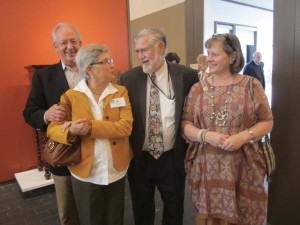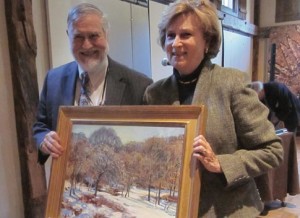Four Centuries of Furniture In and Around Boston
EVENTS > SYMPOSIA
In Review: The Decorative Arts Trust Fall Symposium, 2013
The fall symposium of the Trust, Four Centuries of Furniture in and Around Boston, took Trust members to the exhibits of the collaborative venture of eleven institutions celebrating Four Centuries of Massachusetts Furniture. These exhibits compose the first presentation of rarely seen objects and up-to-date research since Jonathan Fairbanks’ exhibit, New England Begins, some 40 years ago.
Trust members gathered in picturesque Concord, MA, at the quaint Colonial Inn, and from there traveled out each morning to museums, historical societies and historic sites to see the exhibits. The Thursday Optional Tour visited Historic Deerfield where Furniture Masterworks: Tradition and Innovation in Western Massachusetts was the featured exhibit. After a welcome from Deerfield’s Director and Trust Governor, Phil Zea, we heard an excellent lecture by Joshua Lane, Curator of Furniture. The Four Centuries exhibit in the Wright House on Deerfield’s historic mile, displayed the most significant pieces of furniture that show the regional development in cabinetmaking. Lane and his team took several examples of painted regional furniture, analyzed the paint—red lead, white lead, charred bones, ground blue glass suspended in linseed oil, then made a new chest and painted it with true unaged colors. Where the original piece was muted and dull, the new one was a brilliant Prussian blue, orange, and yellow and very bright! Trust members were amazed at this look and knew they were witnessing a new era of how early painted furniture really looked. Ending our glorious fall day at Historic Deerfield with apple cider, Trust members boarded the motor coach and heard a wonderful commentary from Cindy Brockway, a new Trust Governor and Director of Historic Collections for The Trustees of Reservations, the oldest land conservation organization in our country. She explained the economy of the area—mostly rocks, timber, sheep—and described the distinctive New England farmhouse as we drove past many. The house is four rooms on bottom, four on top with an ell or little house attached. The back house connects to the barn as a way to organize work rooms of the farm, hence, big house, little house, back house, barn.
Our opening lecture, across the street at the Masonic Hall, was from Brock Jobe who spearheaded this amazing collaborative venture and reminded us that the North Bennett Street School was still training people in furniture-making today.
The visit to the Massachusetts Historic Society, the oldest in the western hemisphere and home to three presidential libraries—John and John Quincy Adams’ and Jefferson’s (93% of his personal papers and over 400 drawings). Gerry Ward spoke to us about their exhibit, The Cabinetmaker & the Carver, starting from the 18th-century carriage at the Shirley Eustis House, noting the ball and claw footed card table that Phyllis Wheatly, a slave, used for her writing, then the Revival and Reform in Boston, 1860–1900, which is difficult to distinguish from New York, and the Arts and Crafts furniture. Not only was this exhibit one of rarely seen objects but it also, importantly, focused on the people connected with the pieces.
Lunch at the Somerset Club on Beacon Hill was elegant. Our dining room, once the billiard room but recently redone, had wonderful plasterwork and was beautifully painted. The centerpieces for our tables were composed of silver that had belonged to Daniel Webster. Private house visits followed our divine Boston Cream Pie! The Nichols House, a 19th century multi-generational Bullfinch mansion left with all the family furnishings, and the Colonial Society, an historic, intellectual club with good Boston furniture, and two exceptional private collections in important houses rounded out our day on Beacon Hill.
Nonie Gadsden, the Katharine Lane Weems Senior Curator of American Decorative Arts and Sculpture at the Boston Museum and Trust Governor, hosted our visit to the new Wing of the Americas. The great American treasures of the 17th, 18th, and 19th centuries were wonderfully displayed and breathtaking to see. Our final stop in Boston was the ultimate of private collections. We were welcomed as friends, treated to wine and hors d’oeuvres, and encouraged to go to all four floors and enjoy the collection of American furniture, paintings, prints, ceramics, and metals. Trust members returned to Concord happier, perhaps, than we have ever been.
Old Sturbridge Village was an all day affair as we took part in their Collectors’ Forum and the opening of their Four Centuries exhibit, Delightfully Designed—The Furniture and Life of Nathan Lombard. Jim Donahue, President of OSV, welcomed the Decorative Arts Trust and thanked us for our internships that have enabled to OSV to accomplish the work necessary for the exhibit. Jane Nylander, Head of the OSV Collections Committee and Trust Governor, stated the Trust’s mission of supporting internships and scholarships, and introduced Kate Swisher, the Decorative Arts Trust Intern at OSV. Trust members were pleased and proud of this accomplishment. Brock Jobe’s lecture told about the discovery of Nathan Lombard and his furniture. Brock said that the most important book in his library is American Furniture, The Federal Period, by Charles Montgomery, Viking, 1966. The desk and bookcase on the cover is by Nathan Lombard, but Montgomery hedged the attribution in 1966. After several sightings of the telltale signs of this craftsman—swirling patera in diamond inlay, inlay escutcheons—he made the connection with a chest at Winterthur signed Nathan Lombard April 20 1800. Another chest under drawer was signed “Ebenezer Howard Sturbridge.” This put Brock solidly on the trail of furniture craftsmen living in Sturbridge. Today, after much research and locating a number of Lombard pieces, Brock considers Nathan Lombard as a master craftsman rivaling Seymour and McIntyre. Another astounding discovery from the Four Centuries.
Christie Jackson, Curator at OSV, expounded on the inlay as Nathan Lombard’s strong point especially his use of the diamond pattern. She noted that there is 385 feet of sting chevron inlay in the exhibit pieces! Clark Pearce told us about more specifics of Nathan Lombard’s furniture such as the hundreds of candle stands with exuberantly shaped feet, the French feet that are almost always broken or missing, the sand shading with hot sand on veneer and his characteristic banding of small alternating dark and light brown rectangles that create a shimmer effect. As Trust members viewed the exhibit with this information fresh in their minds, they could immediately see the outstanding characteristics of Lombard and began to put a new master in their vocabulary.
After lunch with This Old House star Norm Abrams, who is a huge advocate of supporting the wood craftsmen of today, the Village was open to Trust members, who were highly impressed with the true sense of this early village site—good dirt paths, smoke penciling out of chimneys, villagers spinning, sewing, cooking, and wonderful interiors especially that of the 1748 Parsonage interpreted as c. 1830s, where wallpapers and furnishings gave a comfortable feel of village life.
Winding our way back to Concord, we stopped at the Emerson House, The Old Manse c. 1770, for tours, wine and cheese and a chance to meet board members of The Trustees for Reservations who own and preserve the house. Ralph Waldo Emerson and Nathaniel Hawthorne both lived there.
Sunday morning found Trust members at the Concord Museum where we were greeted by a dear old friend and Honorary Chairman of the Trust, Jonathan Fairbanks. It was Jonathan who, 40 years ago, presented the first comprehensive look at Massachusetts furniture in the exhibit, New England Begins. And, in true Jonathan fashion, he gave us a PowerPoint look at four centuries of Massachusetts furniture, soup to nuts, in grand tutorial style. He recalled names of people involved who made the exhibit possible and throwing in some Jonathan tidbits like wooden pegs were called “trunnels” short for tree nails, and that the later 19th century Boston furniture is the “black hole” because there is still so much to discover. Our final lecturer, David Wood, Curator of the Concord Museum, talked to us about William Munroe, a cabinetmaker in Concord from the late 18th century to 1860, whose journals tell the story of behind-the-scenes life in a cabinetmaker’s shop. This unique social history was fascinating, sometimes brutal but clearly a true representation of the workers’ lives. Afterwards, Trust members enjoyed the Munroe exhibit and the other excellent regional exhibits of the Concord Museum.
The Sunday Optional Tour took members to The Fuller Crafts Museum. Jonathan Fairbanks, Director, led us through their Four Centuries exhibit, Made in Massachusetts: Studio Furniture in the Bay State, which presented colorful, whimsical furniture by living craftsmen. With Jonathan’s enthusiasm for this craft, Trust members immediately became enthralled with the current state of this art. Accompanied by Cindy Brockway, Director of Historic Collections, we stopped at The Trustees of Reservations Archives and Research Center. Many of the furnishings of the historic houses owned by TTR are stored here and much was viewable for Trust members to enjoy. We were struck by the immense difference between “home furnishings” that have become “museum artifacts.” Thanks to Cindy and her staff it was a huge lesson in proper storage and inventorying of artifacts. Our day ended with sunset at the Eleanor Cabot Bradley Estate, another TTR house. Designed by noted architect Charles Platt in 1902 for Dr. Arthur Tracy Cabot, this impressive country home in its natural surroundings brought us into the 20th century architecturally. In the spirit of the times, lovely trays of cheese and crudités were presented to us in the sun room, and wine was poured in the dining room, Trust members made their way around this gracious home appreciating country life of 100 years ago and reflecting on the incredible collaborative effort we have enjoyed at this symposium.





